Group Inquiry # 6
Kahoot is known for its competitive nature as uses points to rank participants based on answering questions correctly as well as the speed at which the questions are answered. However, a more subtle aspect of Kahoot is its ability to promote collaboration in the classroom. The collaborative model is found within the idea of valuing student input which thus leads them to success and puts them at the center of their learning. In the following article (https://kahoot.com/blog/2018/03/13/collaboration-classroom-math-teacher-tips/) one teacher explains his experience with Kahoot and how he started using it simply for a fun break and hadn’t explored many other possibilities until he received feedback from his students.
As such some of the modifications this teacher implemented to make it more collaborative for the students were:
– Warm up (no point game)
– Include I do not know as a possible answer
– Replay Kahoots (to check and reinforce progressions and knowledge)
– Give more time so students do not feel rushed and want to guess
– Break up questions with multiple steps
Kahoot can also be collaborative as there are many teachers and students making Kahoots and sharing Kahoot’s with each other. Students building their own Kahoot games promotes collaboration and focuses on the student being the center of their learning all while learning from others. This fosters a strength-based approach as well as it empowers students to be creative and use what they understand to help others. Also, there is the ability to work as a team/ small groups (this is particularly successful if there is lots of time to answer the questions as it allows discussion among groups instead of rushing). There is also a feature called Team Mode on Kahoot that supports collaboration and this idea of teamwork. This mode gives students time to discuss and then answer. See the following video that explains this mode more in depth.
https://www.youtube.com/watch?time_continue=1&v=PwsJ_sRGudU&feature=emb_logo
Partner: Brittany Johnson
Health and Fitness Update #7
This week I researched a variety of different types of diets. The South Beach diet, the vegan diet, the weight watchers diet and the Mediterranean diet are all different types of diets I have never tried but always wanted to give a shot. Good nutrition is an important part of leading a healthy lifestyle. Combined with physical activity, your diet can help you to reach and maintain a healthy weight, reduce your risk of chronic diseases. There are several benefits of eating healthy, which include weight loss, reduced cancer risk, diabetes management, heart health, strong teeth and bones and improved memory. Below is a description of each diet, and a few images of the types of foods that consist within these diets.
The South Beach Diet:
Link: https://health.usnews.com/best-diet/south-beach-diet
On the South Beach Diet, there are good carbs and fats, and there are unhealthy carbs and fats. The key to weight loss is choosing the best of each. That means lots of no starchy vegetables, fish, eggs, full-fat dairy, protein like chicken and turkey, whole grains and nuts. South Beach is lower in carbohydrates and higher in protein and healthy fats than the typical American diet. South Beach doesn’t categorically eliminate all carbs.
How Does It Work? There are two phases within the South beach diet. Phase one is the weight-loss phase. You will stay in this phase until you reach your desired weight-loss goal or you want more flexibility in your food choices. In phase one, you will limit daily net carbs to 50 grams. You’ll include high-quality protein (such as fish, shellfish, chicken, turkey, lean beef and soy) and no starchy vegetables. You may include very small quantities of beans and legumes, and extremely small amounts of high-fiber fruits like berries and high-protein whole grains like quinoa. Phase two, the maintenance phase, is your lifelong healthy way to eat. You’ll begin to reintroduce more “good carbs,” such as whole grains, low-sugar fruits and starchy vegetables. You’ll also begin to increase your daily net carbs with a goal between 75 and 100 grams per day. You’ll keep up a high protein intake, representing at least 25% of your daily calories, to maintain muscle mass. Although no food is off-limits, some individuals – such as people who are insulin-resistant or postmenopausal women – may have more success by continuing to limit their carbs.

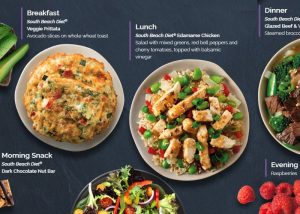

The Vegan Diet:
Link: https://www.healthline.com/nutrition/vegan-diet-guide
A vegan diet contains only plants (such as vegetables, grains, nuts and fruits) and foods made from plants. Vegans do not eat foods that come from animals, including dairy products and eggs.The vegan diet has become very popular. Increasingly more people have decided to go vegan for ethical, environmental or health reasons. When done right, such a diet may result in various health benefits, including a trimmer waistline and improved blood sugar control. Nevertheless, a diet based exclusively on plant foods may, in some cases, increase the risk of nutrient deficiencies. Veganism is defined as a way of living that attempts to exclude all forms of animal exploitation and cruelty, whether for food, clothing or any other purpose. For these reasons, the vegan diet is devoid of all animal products, including meat, eggs and dairy. People choose to follow a vegan diet for various reasons. These usually range from ethics to environmental concerns, but they can also stem from a desire to improve health. There are different varieties of vegan diets. The most common include:
- Whole-food vegan diet: A diet based on a wide variety of whole plant foods such as fruits, vegetables, whole grains, legumes, nuts and seeds.
- Raw-food vegan diet: A vegan diet based on raw fruits, vegetables, nuts, seeds or plant foods cooked at temperatures below 118°F (48°C) (1Trusted Source).
- 80/10/10: The 80/10/10 diet is a raw-food vegan diet that limits fat-rich plants such as nuts and avocados and relies mainly on raw fruits and soft greens instead. Also referred to as the low-fat, raw-food vegan diet or fruitarian diet.
- The starch solution: A low-fat, high-carb vegan diet similar to the 80/10/10 but that focuses on cooked starches like potatoes, rice and corn instead of fruit.
- Raw till 4: A low-fat vegan diet inspired by the 80/10/10 and starch solution. Raw foods are consumed until 4 p.m., with the option of a cooked plant-based meal for dinner.
- The thrive diet: The thrive diet is a raw-food vegan diet. Followers eat plant-based, whole foods that are raw or minimally cooked at low temperatures.
- Junk-food vegan diet: A vegan diet lacking in whole plant foods that relies heavily on mock meats and cheeses, fries, vegan desserts and other heavily processed vegan foods.
Although several variations of the vegan diet exist, most scientific research rarely differentiates between different types of vegan diets.


Google Science Journal
Google Science Journal
What is Google Science Journal? Google Science Journal is a cloud-based platform for K-12 science education. In Google’s own words, Science Journal ‘transforms your device into a pocket-size science tool that encourages students to explore their world. Google Science Journal is a platform that provides science resources and ideas for students and teachers. Its features include; accelerometers, light meters, and more–to help ‘do the science.’ In this way, it combines ideas (e.g., for experiments) and tools (an app that uses your phone’s built-in technology) in an attempt to be a kind of one-stop-shop science platform.
Pro’s & Con’s

Pros:
- A free alternative to expensive classroom light, sound, and motion sensors.
- Interactive for all students.
- Good for the environment (saving paper).
- Leave and explore outside of the four classroom walls.
- A great tool for inquiry based learning.
- Saves time for teachers.
Cons:
- Not all students have a smartphone.
- Confusing for students who struggle with technology.
Science Journal- a Teacher’s Perspective: By using science journal in your classroom, we are inspiring youth to have fun, be creative, engage with hands-on learning and learn new modernized experiments. This app will not only save paper, but it will save time. Most importantly, science journal will enhance our existing lesson plans, add external sensors and move learning outdoors.
Enhance your existing lesson plans
Use Science Journal with activities and assignments you’ve already prepared, and check out other activities that will engage and excite your students. From oscillating chemical reactions to using brightness to estimate the distance of a star, we have an activity that will fit your curriculum.
Add external sensors
With additional external sensors you already have or plan to buy from trusted vendors like Vernier, your students can conduct even more experiments that includes building a weather station or testing body conductivity. Some you may already have, others you’ll want to add to your inventory. Popular sensors include: light, conductivity, temperature, force, gas, heart rate, respiration, radiation, pressure, magnetism, and many more.
Move learning outside
The use of mobile devices along with the types of experiments we offer encourage students to get out of their seats, and open their eyes to the world around them through the power of science.
*Information received from: https://sciencejournal.withgoogle.com/teachers/
In my opinion, I would use google science journal, however I would have to be mindful what grades I am using this with. Being able to link some of these experiments to an elementary aged curriculum can come with challenges. However, for grade, 6-8, I could see how some of these experiments could link well to the curriculum big ideas in science.
Extra Resources:Google Science Journal Videos

The following videos give you a quick look at some of the science explorations you can do with the app in areas of physics and chemistry:
A brief overview of Google Science Journal: https://www.youtube.com/watch?v=9m1h9AVXuf4 (From Rich McCue Slides)
Personalized Learning Project: Acoustic Guitar Update #4
Since my last blog post (video submission of my first song on the acoustic guitar), I have re-chosen my second song to increase the level of difficulty and demonstrate progress throughout my personalized musical journey on the acoustic guitar. After much deliberation and thought the second song I have chosen was Yellow Bird by Michel Mauleart Monton. This song was composed in 1957 and is quite unique as it is in the Key of A. Yellow Bird was a challenging song to find as there was not sheet music on the internet. Luckily, I was able to use the UVIC library as a resource and found sheet music for the song. I wrote out the sheet music and converted it into a way I would understand. (See images of sheet music below). The reason, I have decided to change from my original second song is because in Yellow Bird, I am able to learn two new chords: A and E and also learn a more difficult strumming pattern (down, down, up, drop hand, up, down). I will remain to play the D chord with fingers one and two, excluding finger three. As when I was born I was born with a rare hand condition where my fingers were stuck together, although this was corrected at a very young age. I do still struggle with bending my third finger a specific way. Therefore, this is one adaptation I will not be able to change. To begin learning this new piece, during the next week I will focus on learning the strumming pattern and also learning how to play my two new chords: A and E.
Images of Altered Sheet Music: (click link to open)
Inquiry Based Lesson Plan: WHAT IS A BUTTERFLY?
WHAT IS A BUTTERFLY?
- WHAT I SEE
- WHAT I KNOW
- WHAT I WONDER
Lesson Plan
Grade: 1
Time: 30 Minutes
Beginning the lesson: The students will explore the nearby butterfly garden. While they are exploring the garden they will observe and note in mind what they see, what they know and what they wonder about butterflies. (This is what the lesson will be based on- not included into time allocated to this activity).
What I See: The teacher will assign the students into pairs, what they will think, pair and share what they saw when they were outside exploring in the garden. Debrief: Class discussion based on the images of the different types of butterflies.This activity will be done by having the teacher choose the students whose hands are raised and sitting quietly and listening. (5-8 Minutes)
What I Know: The teacher will begin by showing and sharing the GIF of the butterfly whose wings are flapping. They will each receive a q card and write down as much as they can about what they know about butterflies and are welcome to draw a small picture on the backside of their q cards if they finished early. After this part of the activity is completed, they will discuss their findings as a whole class. (5-8 Minutes)
What I Wonder: I noticed the students were interested in drawing butterflies and wondered how to symmetrically make them. If the students are interested in drawing the butterflies then we will explore how to symmetrically draw butterflies using different mediums, such as: watercolour. By following along with the Youtube Video the students will be able to participate in an art activity and explore new relevant skills. This part of the lesson plan will take the majority of the time. (15-20 Minutes)
Video Link: https://drive.google.com/file/d/1ZlMeeO_4f8V1QDXvUkw_CpiIjLxydRjD/view
By: Angie Cauthers, Madeline Osgarby & Arnelle Basi
Health and Fitness Update #6
 @ashleigh_jordan
@ashleigh_jordan
I would like to begin this week’s blog post by talking about one of my biggest health and fitness inspirations: Ashleigh Jordan. Ashleigh’s social media Instagram page is filled with several different workout programs, which are very specific to different parts of the body. Something I found very unique about her that most fitness pages or people do not include in their workout programs are partner workouts. Therefore, if you are working out with a friend, there are several different things you can do, which are benefiting yourself and is considered a fun workout. Since recently discovering Ashleigh Jordan’s fitness page, I have been closely following her workouts and adapting my workouts with hers as we have similar goals.
This week, I kept a similar diet having protein bars, protein smoothies and salads with chicken breasts. To meal prep, I bought a big Caesar salad from save on foods, which lasted me seven whole days. I also marinated 5 chicken breasts in BBQ sauce and cooked them and chopped them up for my salads. I tried very hard to cut pasta out of my diet this week as well as rice as I found that it was too many carbohydrates for myself. Additionally, something new I incorporated into my diet was
This week, for my fitness journey I continued to work out Wednesdays, Saturdays and Sundays after work. Like I already mentioned I changed my routine and decided after much thought and consideration that I would break up my workouts into focusing on different parts of the body each day, for example: upper body, lower body and then mix cardio into their as well. As my beliefs are still the same, I always separate legs into its own day, because of the amount of exercises I have for legs. Some of Ashleigh Jordan’s work outs include; leg burner, partner workouts, under and upper booty, side booty, killer abs, home abs, delts, total thighs, abs, legs, oblique’s, full booty, upper blast, warm ups, shoulders, etc.
Instead of focusing on images from my own personal inquiry journey this week, I would like to show you all some images and videos of Ashleigh Jordan’s fitness journey as I believe she can and will inspire several others.
Video Link: https://www.youtube.com/watch?v=ptDXT_kUSkM

My Inspiration

Group Inquiry Post #5
 This week, we decided to take a unique perspective and look at our overarching question through the perspectives of students. By changing our point of view, we will look at what students think of Kahoot and Kahoot’s influence on teaching and learning. As we already know technology is on the rise and is being increasingly integrated into teaching environments in view of enhancing students’ engagement and motivation. Kahoot is an exemplar example of this and as it fosters student engagement and improves overall students’ learning experience.
This week, we decided to take a unique perspective and look at our overarching question through the perspectives of students. By changing our point of view, we will look at what students think of Kahoot and Kahoot’s influence on teaching and learning. As we already know technology is on the rise and is being increasingly integrated into teaching environments in view of enhancing students’ engagement and motivation. Kahoot is an exemplar example of this and as it fosters student engagement and improves overall students’ learning experience.
As we both work and volunteer in classrooms and currently work with school aged children, we are given the luxury to create relationships and build connections with youth. Within the past week, we have asked a bunch of students in a variety of different ages and grades what they think about Kahoot and if they use it in their classrooms. Almost 95% of the students we spoke to have used Kahoot in previous years or are using Kahoot currently. Some student testimonies are as the following:
Grade 1:
- We like how much fun it is!
Grade 3:
- We like the fact that it’s a game.
- We like that we can play against people.
Grade 12:
- It is a great study method and makes learning fun.
- It’s a great way to study in a group of people and quiz each other on class material.
In relation to external resources we found an article, which fits very well with this week’s topic. The article “Students’ perception of Kahoot’s influence on teaching and learning” acknowledges the outcomes of research that examined students’ experience using a game-based student response system, Kahoot in an Information Systems Strategy and Governance course at a research-intensive teaching university in New Zealand. Some of the key findings from the article revealed that Kahoot enriched the quality of student learning in the classroom, with the highest influence reported on classroom dynamics, engagement, motivation and improved learning experience. Our findings also suggest that the use of educational games in the classroom is likely to minimize distractions, thereby improving the quality of teaching and learning beyond what is provided in conventional classrooms.
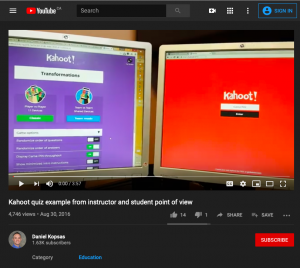
This YouTube video (link): https://www.youtube.com/watch?v=YtH4kYacFs4 discuses and demonstrates hot Kahoot is and can be viewed from an instructor and student point of view.
Partner: Brittany Johnson
Impressions and Thoughts on Rebecca Bathurst’s Kindergarten Classroom @ George Jay Elementary School

Today, my cohort and I were lucky enough to have the chance to speak to Rebecca Bathurst, a kindergarten teacher at George Jay Elementary School. I was very excited and have been looking forward to meeting Rebecca, as in our Literacy and Language Class last semester, our professor mentioned and referred to Rebecca’s work quite often. She also gave us her Instagram name; therefore, we could follow along with the work she does in her classroom. I have truly been inspired and have been following Rebecca’s work for a few months now. As we attended George Jay Elementary School and were able to observe a variety of inquiry projects the kindergarteners were working on. As I arrived early I got the chance to talk to Rebecca about her journey through the Elementary Education program at UVIC. She mentioned that after graduating with her masters, she was a part of the EXPLORE program, where she was able to travel and work and find what she was most passionate about as a teacher and what she wanted to bring into her classroom. Rebecca spoke to us about her experiences as a teacher and focused on Inquiry based learning and what it means to have an inquiry mindset. Rebecca discussed the different types of inquiry such as: structured, controlled, guided and free inquiry. She explained and gave several examples of how to do each of these. I have never been so truly inspired. Throughout Rebecca’s talk she stressed the importance of beginning a lesson with a question, therefore you are guiding and allowing children to think of three specific things; what we see, what we know, and what we wonder. Rebecca also mentioned the importance of provocations and I totally agree with her about how this can create and inspire curiosity for our learners. All in all, she pursued us how to incorporate more inquiry into our teachings and demonstrated how to relate students interest and inquiry to the BC curriculum. Some advice Rebecca gave us about our practicums that really touched me and I was able to relate to was that she mentioned how we as teachers set high standards and expectations for ourselves and practicums and learning in general is so set up so we do fail and that failure is okay is the process of learning. This touched me, because I am one of those people who am very hard on myself and set high standards. Additionally, while we explored Rebecca’s kindergarten classroom, I was able to take a few images of what I thought was unique and I would potentially incorporate into my future classroom. I really enjoyed that the classroom did not feel like a classroom and felt more like a home. Below are a few images of the layout of Rebecca’s classrooms and a few centers/objects she had out for the students to play with. Ultimately, this field trip was very beneficial for myself, because I would like to become a kindergarten teacher as well, and seeing a unique creative classroom setup and a different way of teaching made me excited for my practicum and future as an elementary school teacher.



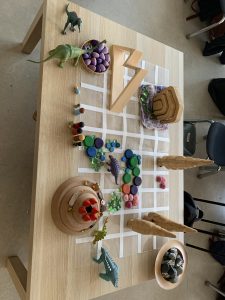

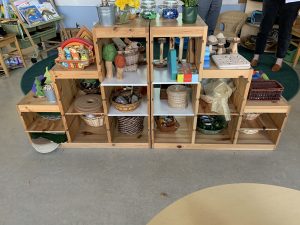
Musicianship Goal Action Plan: Midterm Video Submission
Musicianship Goal Action Plan: Midterm Video Submission
Script: According to my musicianship goal action plan, I will begin my video submission of my personalized learning project by stating what I have achieved throughout my journey. As guaranteed, I am now able to hold the guitar properly, and I have learned two ways to tune my guitar, one of which is using the app on my iPhone called Guitar tuner (electronic) and the other way is on a manual guitar tuner. I was able to find and learn the sheet music for the “Lion song” and practice the chords: D, G and A7. Some adaptations I made to the sheet music was to instead of using all three fingers for the D chord, I adapted the chord to using only fingers 1 and 2 on strings 3 and 1. For the chorus of the song I also adapted the strumming pattern, therefore I had enough transition time in between chords, to ensure I was staying on beat throughout the entirety of the song. Ultimately, I have gained a vast amount of knowledge about the acoustic guitar and about the process of self-teaching and reflection. I can recognize that I have achieved my initial goal of performing my chosen song consecutively without any pauses, and without referring to my notes. Throughout this astonishing journey, I am able to demonstrate the correct fingering, smooth chord transitions and the appropriate strumming patterns of the “Lion song” on a classical acoustic guitar.
Video #1: Explanation & Script
Video #2: “The Lion Song”
Group Inquiry Post #4
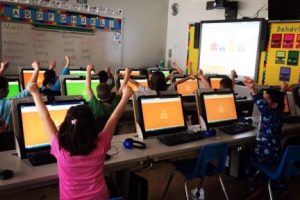 Kahoot is really an enjoyable experience and is a shared learning platform used throughout the world. This video demonstrates how it is used with various age groups, populations as well as places and the excitement it brings to learning. https://www.youtube.com/watch?v=lGLy9jyGjkU (the photo above is also from that video). As such, this week we decided to outline our personal experiences with Kahoot both as students and as emerging teachers as we thought it would be nice to understand both perspectives.
Kahoot is really an enjoyable experience and is a shared learning platform used throughout the world. This video demonstrates how it is used with various age groups, populations as well as places and the excitement it brings to learning. https://www.youtube.com/watch?v=lGLy9jyGjkU (the photo above is also from that video). As such, this week we decided to outline our personal experiences with Kahoot both as students and as emerging teachers as we thought it would be nice to understand both perspectives.
Personal Connections (Below both my partner and I described our own stories of how we have seen Kahoot being used as a game-based learning platform and how it has motivated students to learn).
Arnelle: From volunteering in classrooms, to practicum’s and observational Wednesday visits last semester, I have seen the impact that Kahoot and all game-based learning has on an individual child and their motivation to learn. I have observed that all students are included and participate in Kahoot, I have also observed that Kahoot allows students to work collaboratively, it allows them to work individually and allows students to be competitive or play in a cooperation game style. A story, that came to my mind, while writing this week’s blog post was that, when I was observing a grade 5 classroom, the class was studying English language arts, and focusing on spelling, therefore the teacher had constructed a Kahoot, and put the students in groups of 4, with one IPad per group. The students were able to work collaboratively, and find the correct spelling to the word/ sentences the teacher said out loud. This technique was very useful, ad beneficial for the students, but also the teacher, therefore she could see who was understanding and succeeding and depict those who were struggling, and not helping their groups.
Brittany: My experience with Kahoot has extended from my high school years (it was launched in my grade 9 year) all the way to post-secondary (university). Kahoot is motivating for me as a student, I remember asking to play (intrinsic motivation), as it really helped me engage in learning and understand concepts. This fun interactive surface was able to make it so that children in the class could individually respond or collaboratively work together in small groups. In a classroom that I observed in, we used Kahoot both as a fun way to assess the classrooms understanding as a whole but also children were able to create their own Kahoot questions and play each other’s Kahoot’s as well. This idea extends beyond just the teacher instructing and allows children to create their own games which helps facilitate an engaging atmosphere for the students. I have experienced Kahoot both as a student and while observing various classrooms and I can honestly say that children are asking for Kahoot because they benefit from this learning platform.
Partner: Brittany Johnson